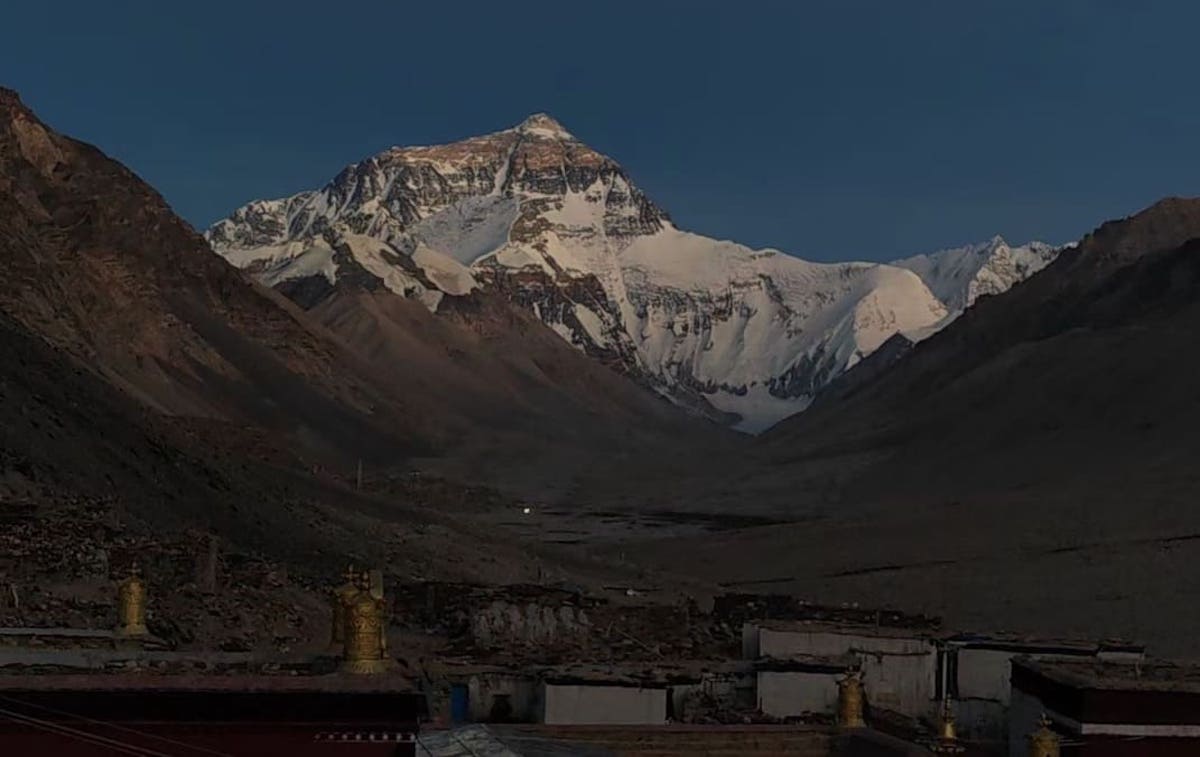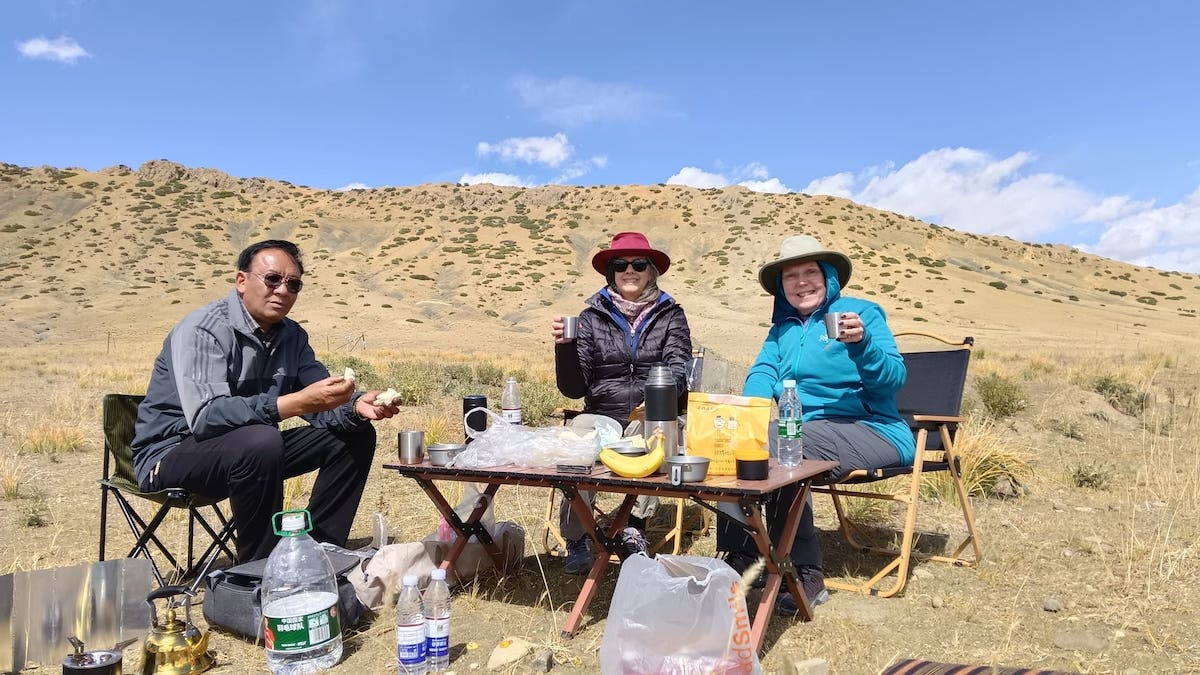
Traveling to Mount Everest Base Camp in Tibet in Summer
Standing tall at 8,848.86 meters (29,031.7 feet), Mount Everest is the world’s highest peak and a dream destination for adventurers across the globe. While most people think of climbing it from Nepal, the north face of Mount Everest in Tibet offers a unique and less crowded experience. Visiting Everest Base Camp (EBC) in Tibet during the summer months is one of the most thrilling and visually rewarding journeys available to travelers in Asia.
This blog post provides an in-depth guide to traveling to Mount Everest in Tibet during the summer, including the route, itinerary, highlights, and what to expect from this breathtaking Tibet trekking and sightseeing experience.

Mount Everest in Tingri
Table of Contents
Why Travel to Mount Everest in Tibet During Summer?
Summer (May to September) is an ideal season for visiting Mount Everest in Tibet, especially if you’re interested in photography, outdoor exploration, and engaging with Tibetan culture.
✅ Mild Weather
- Summer brings warmer temperatures and relatively stable weather conditions, making high-altitude travel safer and more comfortable.
- While days are warm, especially at lower altitudes, nights at Everest Base Camp can still be cold, so layered clothing is essential.
✅ Clear Views
- June and early July often offer clear skies in the mornings, which are perfect for unobstructed views of Mount Everest and the surrounding Himalayas.
✅ Vibrant Culture
- This is also a time when Tibetan nomads return to higher pastures, and several cultural festivals, such as Saga Dawa and Shoton Festival, may coincide with your Tibet tour.

Mount Everest in Tibet
Overview of Mount Everest Base Camp in Tibet
Unlike the southern base camp in Nepal, which requires multi-day trekking, the north Everest Base Camp in Tibet is accessible by vehicle, with an optional short trek. Located at an elevation of 5,200 meters (17,060 feet), this base camp offers dramatic views of the north face of Mount Everest, far away from the crowds on the southern route.
Visiting EBC from Tibet provides:
- A panoramic view of Everest’s massive north face
- A chance to explore ancient monasteries and nomadic culture
- The thrill of overland travel across the wild, windswept Tibetan Plateau
Route and Travel Options
Traveling to Mount Everest in Tibet requires joining a licensed travel agency due to regulations imposed on foreign tourists. You cannot travel independently in Tibet. Here’s how most travelers reach Everest Base Camp:

Tibet Everest Base Camp Tour
Step 1: Entering Tibet
You can fly or take a train to Lhasa, the capital city of the Tibet Autonomous Region. Popular entry points include:
- Chengdu, Beijing, or Xi’an in China
- Kathmandu, Nepal, via land or a short flight (requires a different visa process)
Step 2: Overland Journey to Everest Base Camp
From Lhasa, travelers typically take a scenic overland route to EBC via:
- Yamdrok Lake – A turquoise sacred lake
- Gyantse and Shigatse – Home to stunning monasteries and Tibetan markets
- Tingri and Rongbuk Monastery – Gateway to Everest
The journey covers about 800 km and usually takes 4–5 days one way, including acclimatization stops.
Suggested Tibet Tour Itinerary with Everest Base Camp
Here’s a sample Tibet tour itinerary that includes Mount Everest Base Camp in summer:
Day 1–3: Lhasa Acclimatization
- Visit Potala Palace, Jokhang Temple, and Barkhor Street
- Explore Sera and Drepung Monasteries
- Rest to adapt to the altitude (3,656 m)
Day 4: Lhasa to Gyantse (via Yamdrok Lake)
- Cross the Gampala Pass (4,790 m) for panoramic views
- Visit Yamdrok Lake, Karola Glacier, and Pelkor Monastery
Day 5: Gyantse to Shigatse
- Explore Tashilhunpo Monastery, seat of the Panchen Lama
- Enjoy a drive through the vast Tibetan plains
Day 6: Shigatse to Tingri
- Drive through dramatic landscapes
- Optional stop at local villages for cultural immersion
Day 7: Tingri to Everest Base Camp
- Pass Gawu La Pass (5,198 m) with views of five 8,000+ meter peaks
- Arrive at Rongbuk Monastery (5,000 m)—the world’s highest monastery
- Short trek or drive to Everest Base Camp (5,200 m)
- Watch the sunset glow on Mount Everest in Tibet
Day 8: EBC to Shigatse
- Return journey with optional detours for more cultural stops
Day 9–10: Back to Lhasa / Fly out

Tibet group tour in Lhasa
Everest Base Camp Trekking Experience in Tibet
While the EBC in Tibet is accessible by vehicle, many adventurers choose to hike the final stretch from Rongbuk Monastery to Base Camp (~4 km each way). It’s a short but challenging Tibet trekking experience due to the altitude.
For those wanting a longer trek:
- The Old Tingri to EBC trek (4–5 days, ~70 km) is an option.
- This rugged trail offers solitude, high mountain passes, herder camps, and the chance to experience Everest slowly and intimately.
Trekking Tips:
- Take it slow: Acclimatization is essential.
- Drink plenty of water.
- Use trekking poles and wear proper boots.
- Hire a yak or porter for heavier loads if needed.
Accommodations at Everest Base Camp
At EBC, accommodations are basic due to the harsh conditions and remote location:
- Tent Guesthouses (Yak Hair Tents): Operated by locals in summer, with beds and simple meals
- Rongbuk Monastery Guesthouse: Offers basic dormitory rooms and monastery meals
- Toilets: Usually dry pit-style, located outside the tents
Note: Tented guesthouses are usually only open from May to October, making summer the perfect season to stay near the base camp.
Tibet Trekking and Everest Travel Permits
All foreign travelers need several permits for a Tibet tour, especially for reaching Mount Everest in Tibet:
- Tibet Travel Permit (TTP) – Required for entry into Tibet, issued by the Tibet Tourism Bureau.
- Aliens’ Travel Permit – Needed for traveling outside Lhasa to areas like Shigatse and Everest.
- Border Pass – Required for Everest and border regions.
- Chinese Visa – A standard visa obtained from a Chinese embassy.
A licensed Tibet travel agency will arrange all these permits as part of your tour package.
What to Pack for a Summer Trip to Everest Base Camp in Tibet
Even in summer, conditions near Mount Everest can be extreme. Here’s a list of essentials:
- Warm clothing: Down jacket, fleece, base layers
- Rain jacket and windproof outerwear
- Trekking boots: Waterproof with good ankle support
- Sunglasses and sunscreen
- Sleeping bag: Rated for sub-zero temperatures
- Reusable water bottle and water purification tablets
- Altitude medication: Such as Diamox (consult a doctor)
- Snacks: Energy bars, nuts, and electrolytes
Cultural Tips and Etiquette
Traveling in Tibet requires cultural sensitivity. Here are a few tips:
- Do not photograph monks without permission.
- Walk clockwise around stupas and monasteries.
- Respect local customs—avoid discussing politics.
- Be patient and polite when interacting with locals.
Visiting Rongbuk Monastery offers a chance to learn about Tibetan Buddhism firsthand, so attend a prayer session if invited.
Health and Safety Considerations
High-altitude travel comes with risks. Be prepared for Acute Mountain Sickness (AMS):
- Symptoms: Headache, nausea, dizziness, fatigue
- Prevention: Gradual ascent, hydration, rest
- Emergency: Oxygen tanks are available at guesthouses and in tour vehicles
Most people adapt well with proper acclimatization. Your guide will monitor your health and take precautionary measures.
Highlights of Visiting Mount Everest in Tibet
- Unparalleled Views: The North face of Mount Everest, especially during sunrise and sunset
- Rongbuk Monastery: Spiritual tranquility at the foot of the Himalayas
- Panoramic Passes: Gawu La Pass offers views of Everest, Lhotse, Makalu, and Cho Oyu
- Remote Adventure: Experience the raw beauty of the Tibetan Plateau
- Cultural Immersion: Monasteries, nomadic villages, and traditional Tibetan life

Conclusion
A summer trip to Mount Everest Base Camp in Tibet combines epic scenery, cultural richness, and spiritual depth. Whether you’re a thrill-seeker, trekking enthusiast, or simply a lover of high-altitude landscapes, standing in the shadow of the mighty Mount Everest in Tibet is an unforgettable experience.
With good preparation, the right permits, and a guided Tibet tour, this adventure becomes not only feasible but deeply fulfilling. Whether you’re driving across the Roof of the World or taking on a Tibet trekking challenge, the grandeur of Everest and the hospitality of the Tibetan people will leave a lasting impression on your soul.
Recent Posts
Overland Tour in Tibet in Winter
Visiting Tibet in Winter
How to Book a Tibet Tour in Winter 2025
All Categories
- About Tibet
- book a Tibet tour
- Buddhism Practice
- Budget Tour
- China-Tibet Train
- Customized Tibet tour
- Historical Sites
- Hot Springs in Tibet
- News
- Photography in Tibet
- Tibet attraction
- Tibet Group Visa
- Tibet Motorcycle Tour
- Tibet Small Group Tours
- Tibet Tours and Tibetan Tour Guide
- Tibet Train
- Tibet Travel FAQs
- Tibet Travel Information
- Tibet Travel News
- Tibet Travel Permit Update
- Tibet Travel Prices Rises
- Tibet Trek
- Tibet Trekking Tour
- Tibet weather and climate
- Tibet Wildlife animals
- Tibet Winter Tour
- Tibetan Buddhism
- Tibetan Cultural Features
- Tibetan Culture and Poeple
- Tibetan Festivals
- What to see in Tibet



